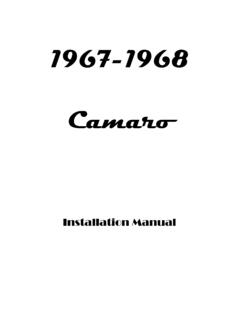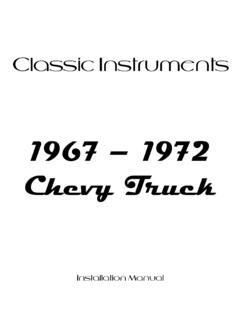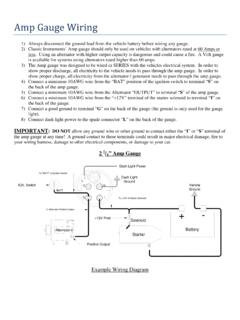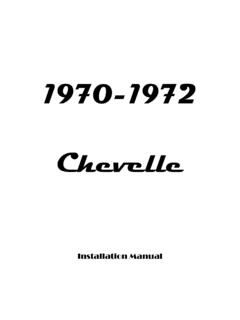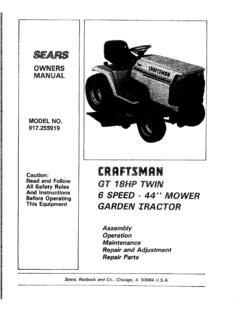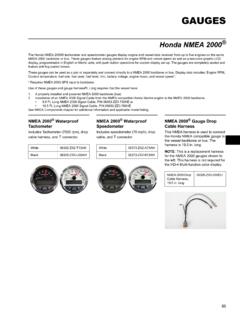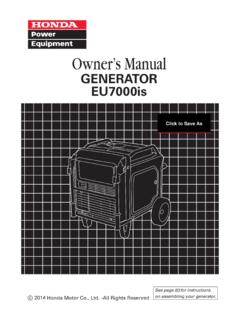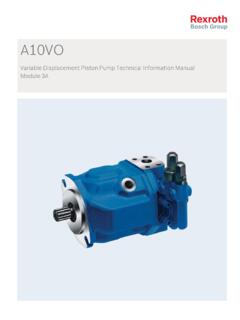Transcription of 1957 Chevy Installation Manual Revision 010615
1 Classic Instruments 1957 Chevy Installation Manual Revised: January 6, 2015 Page 2 Table of Contents Welcome from the Team at Classic Instruments! .. 3 Mounting Gauges .. 4 Speedo, Tach, Volt and Oil Pressure gauge Wiring .. 5 Speedo, Tach, Volt and Oil Pressure gauge Wiring Diagram .. 6 Temperature gauge Wiring .. 7 Temperature gauge Wiring Diagram .. 7 fuel gauge Wiring .. 8 fuel gauge Wiring Diagram .. 8 Pulse Signal Generator [SN16] Wiring .. 8 Oil Pressure Sender Installation .. 9 Temperature Sender Installation .. 10 Clock (optional) Wiring .. 11 Clock Wiring Diagram .. 11 Speedometer & Tachometer Calibration .. 12 Entering Calibration Mode: .. 12 Tachometer Cylinder Setup: .. 12 Tachometer Signal Type Setup: .. 13 Speedometer Instant Calibration: .. 13 Speedometer Real-Time Calibration: .. 14 Speedometer Measured Mile Calibration: .. 14 Optional Shift Indicator Setup: .. 15 Reset gauge Calibration to Factory Defaults: .. 15 Revised: January 6, 2015 Page 3 Welcome from the Team at Classic Instruments!
2 Our congratulations and appreciation for your purchase of one of the finest quality sets of specialty instruments ever produced! Your instrument set has been conceived, designed, and manufactured by Classic Instruments, Inc. in the Each instrument has been tested and certified for accuracy and quality before packaging and shipping. For trouble-free Installation and operation follow the instructions exactly as outlined. Your instruments were assembled to precise specifications and although each has a seven (7) year warranty covering defective parts and workmanship this warranty will not cover instruments or sender units which have been installed incorrectly. Follow our recommended procedures for Installation and proper hookup to maintain the value and appearance of your instrument set during many future years of accurate and dependable service! LIMITED WARRANTY Classic Instruments, Inc. (CI) warrants to the original purchaser that any CI product manufactured or supplied by CI will be free from defects in material and workmanship under normal use and service for a period of seven (7) years from date of purchase.
3 Improper Installation , use of sending units other than CI s or attempted repair or adjustments by other than CI shall void this warranty. Disassembly of any instruments or senders for whatever reason shall specifically void this warranty. It s always easy to look to a part for an issue with your set. Before you conclude that a part may be bad, thoroughly check your work. Today s semiconductors and passive components have reached incredibly high reliability levels , but there is still room for error in our human construction skills. However, on rare occasions a sour part can slip through. Please be aware that testing can usually determine if the part was truly defective or damaged by assembly or usage. Don t be afraid of telling us that you blew it , we re all human and in most cases, replacement parts are very reasonably priced. Purchaser requesting a product to be repaired or replaced under warranty must first call CI at 1-800-575-0461 before the return of defective part.
4 Send defective part to 826 Moll Drive, Boyne City, MI 49712, USA. Include a written description of the failure with defective part. Purchaser agrees and accepts that under no circumstances will a warranty replacement be furnished until CI has first received, inspected, and tested the returned part. All other warranties expressed or implied are hereby excluded including any implied warranty of merchandise and implied warranty of fitness for a particular purpose. The sole and exclusive remedy for breach of this warranty is limited to the replacement set forth above. It is expressly agreed that there shall be no further remedy for consequential or other type of damage, including any claim for loss of profit, engine damage or injury. TECHNICAL ASSISTANCE 1-800-575-0461 OR Visit our website for the latest in gauge design and updates to our Installation Manual Revised: January 6, 2015 Page 4 Mounting Gauges 1) Disassemble the dash, removing the original gauges and brackets.
5 Save the original bezels. (Figure 1) Your new gauges utilize the original bezels for optimum fit. FIGURE 1 FIGURE 2 2) With the dash face down on a flat surface, place the original bezels in their proper locations. (Figure 2) Note: The large center bezel has a notch and the two small bezels each have two holes. The notch and the holes should be placed at the bottom of the mounting openings. 3) Place round center bracket around the 5 gauge and insert it in the dash panel. Note: The top of the bracket is indicated by the narrower notch and should be aligned with the top of the gauge . 4) Using (4) 6-32 x 3/8 screws and lock washers, correctly align the gauge so the dial is straight, and firmly fasten the bracket to the dash. 5) Place the small gauges over the original bezels. Install the 3-3/4 brackets across the top two gauge studs and secure the brackets with (2) 8-32 x 1/2 screws and lock washers. (Figure 4) IMPORTANT: The gauge posts may need to be shortened to avoid contact with the cowling which may cause a short.
6 FIGURE 3 Revised: January 6, 2015 Page 5 Speedo, Tach, Volt and Oil Pressure gauge Wiring 1) Always disconnect the vehicle battery before wiring any gauge . 2) Connect a switched +12 VDC power source to the PINK wire of the gauge cluster wire harness. We recommend using a dedicated power source to avoid possible problems caused by bad noisy power. 3) Connect a good chassis ground to the BLACK wire of the gauge cluster wire harness. We recommend using a dedicated chassis ground (not stacked with other ground wires) to avoid possible problems caused by a bad ground. 4) Connect a speed signal from one of the following sources to the PURPLE wire of the gauge cluster wire harness: a. White signal wire from a pulse signal generator [SN16] i. See Pulse Signal Generator Wiring section for complete SN16 wiring instructions. [OR] b. One wire (either one will work) from an electronic vehicle speed sensor (VSS) that is NOT going to be connected to the vehicle computer.
7 (This is the option for many Tremec and 700R4 transmissions.) i. Connect the other wire of the VSS to the same ground point as the BLACK wire from step 3. [OR] c. Speed signal wire from the vehicle computer. (This is usually a green wire in GM LS engine harnesses.) 5) Connect the RED wire of the gauge cluster wire harness to the Red wire of a SN16 pulse signal generator. DO NOT USE the Red wire if a SN16 is not being used. (it does not require power) 6) Connect a tachometer signal to the WHITE wire of the gauge cluster wire harness. a. STANDARD POINTS & CONDENSER SYSTEM i. Connect to the negative side of the coil (usually marked as - ). b. GMC HEI (High Energy Ignition System) i. Connect to the TACH terminal on coil side of distributor cap. c. MSD (Multiple Spark Discharge System) i. Connect to the TACH signal from the MSD box. d. VERTEX MAGNETO SYSTEM i. Connect to the KILL terminal on the side of a Vertex magneto body. An external adapter such as an MSD Pro Mag Tach Converter #8132 may be required.
8 E. ACCEL IGNITION COILS i. Connect to the negative side of the coil. CAUTION! Some Accel ignition coils require the tach signal wire to be connected to the + terminal on the coil! PLEASE carefully read Accel s instructions before connecting ignition coil. f. MALLORY IGNITION i. Connect to the negative terminal side of coil (usually marked as - ). g. PCM TACHOMETER SIGNAL i. Connect to the signal from the computer. The tachometer typically needs to be set on 4 cylinder setting. h. MULTIPLE COIL IGNITION SYSTEMS i. A tach adapter may be required for these ignition systems. A tach signal driver such as the MSD #8913, which produces a 12V square wave signal, is recommended. Please check with manufacturer for your specific application. i. NOTICE! For all other ignition systems please look at the owner s Manual for that system. 7) Connect the oil pressure sender to the BLUE wire of the gauge cluster wire harness. 8) Connect high beam indicator power to the GREEN wire of the gauge cluster wire harness.
9 9) Connect dash light power to the GREY wire of the gauge cluster wire harness. Revised: January 6, 2015 Page 6 10) Connect either wire of the momentary contact setup pushbutton to the BROWN wire of the gauge cluster wire harness. a. Connect the other wire of the pushbutton to ground. 11) Optional Connection (must be special ordered): Connect left turn indicator power to the BLUE / WHITE wire of the gauge cluster wire harness. 12) Optional connection (must be special ordered): Connect right turn indicator power to the PURPLE / WHITE wire of the gauge cluster wire harness. 13) The YELLOW wire of the gauge cluster wire harness is NOT USED. Speedo, Tach, Volt and Oil Pressure gauge Wiring Diagram High Beam Indicator [GREEN]Good Chassis Ground [BLACK]Optional Left Turn Indicator [BLUE / WHITE]Speedometer Signal [PURPLE]Dash Light Power [GREY]Filtered Power Output to SN16 (if equipped) [RED]Setup Button Connection [BROWN]Optional Right Turn Indicator [PURPLE / WHITE]Oil Pressure Signal [BLUE]Tachometer Signal [WHITE]Not Used [YELLOW]+12 VDC Switched Power [PINK]+ACC Revised: January 6, 2015 Page 7 Temperature gauge Wiring 1) Always disconnect the vehicle battery before wiring any gauge .
10 2) Connect a switched +12 VDC power source to the post marked I on the back of the temperature gauge . 3) Connect a good chassis ground to the post marked G on the back of the temperature gauge . This post also has the bracket which holds the gauge in the dash over it. 4) Connect the temperature sender to the post marked S on the back of the temperature gauge . 5) Connect dash light power to the spade terminal marked L on the back of the temperature gauge . Temperature gauge Wiring Diagram Ground+12 VDC switchedDash Light PowerGOLSIS ignal WireLock WasherNutWasherRing TerminalIntake ManifoldTemperature SenderDo not use teflon tape on the threads ofthe sender since this interferes with thesender's ground connectionPart Numbers:SN25, SN24,SN23 or SN22 Revised: January 6, 2015 Page 8 fuel gauge Wiring 1) Always disconnect the vehicle battery before wiring any gauge . 2) Connect a switched +12 VDC power source to the post marked I on the back of the temperature gauge .
